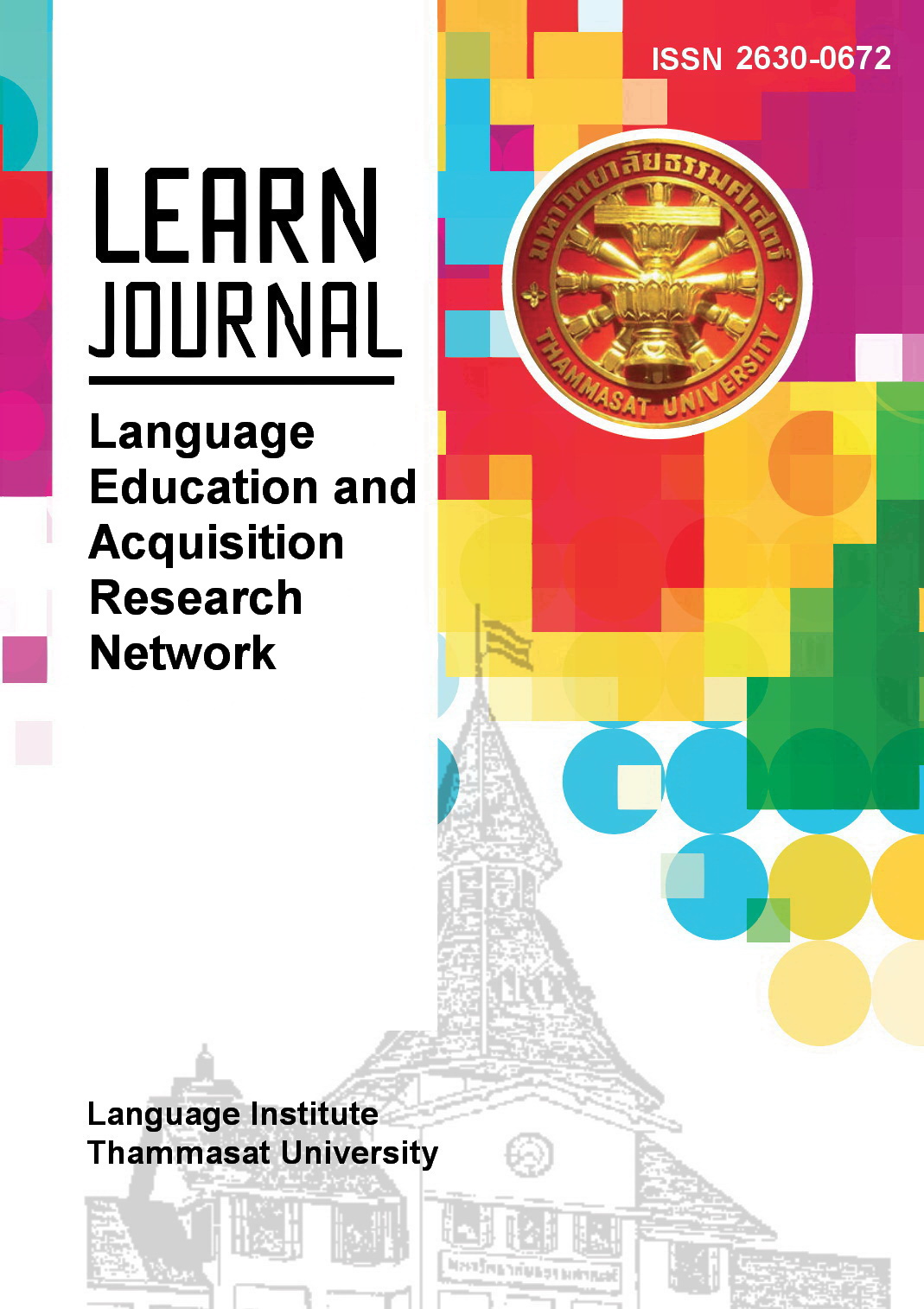Investigating Washback Effects on Teaching: A Case Study of An Exit Examination at the Higher Education Level
Main Article Content
Abstract
In Thai contexts, studies on washback effects of high-stakes tests have been investigated extensively at the high school level. However, little is known about the occurrence of washback effects of high-stakes tests on teaching at the higher education level. This study aimed to investigate the washback effects of the Srinakharinwirot University Standardized English Test (SWU-SET), which is implemented as an exit examination for undergraduate students at a Thai public university in Thailand, on teaching English. The research question was: What are the washback effects of the SWU-SET on teaching? A mixed-methods design was employed to answer the research question. In total, 25 university teachers completed the teacher questionnaire, five of whom were purposively selected to be the informants. The main findings show that the SWU-SET induced the teachers to put their effort into helping students achieve the course objectives and the test objectives. The findings reveal that the SWU-SET and its underlying concept allowed the teachers to make connections between teaching, learning, and assessment. This study suggests that teachers should be aware of the importance of making connections between curriculum, teaching, learning, and tests in their teaching routines.
Article Details
References
Afflerbach, P. (2002). Verbal reports and protocol analysis. In M. L. Kamil, P. B. Mosenthal, P. D. Pearson, & R. Barr (Eds.), Methods of literacy research: The methodology chapters from the handbook of reading research (pp. 87-103). Lawrence Erlbaum Associates. https://doi.org/10.4324/9781410604460
Akiyama, T. (2003). Assessing speaking in Japanese junior high schools: Issues for the senior high school entrance examinations. SHIKEN: JLT Testing & Evaluation SIG Newsletter, 7(2), 2-8. https://hosted.jalt.org/test/PDF/Akiyama1.pdf
Alderson, J. C. & Hamp-Lyons, L. (1996). TOEFL preparation courses: a study of washback. Language Testing, 13(3), 280-297. https://doi.org/10.1177/026553229601300304
Alderson, J. C. & Wall, D. (1993). Does washback exist? Applied Linguistics, 14, 115-129. https://doi.org/10.1093/applin/14.2.115
Ali, M. M., Hamid, M. O. & Hardy, I. (2020). Ritualisation of testing: Problematising high-stakes English-language testing in Bangladesh. Compare: A Journal of Comparative and International Education, 50(4), 533-553. https://doi.org/10.1080/03057925.2018.1535890
Bachman, L. F., & Palmer, A. S. (1996). Language testing in practice. Oxford University Press.
Damankesh, M. & Babaii, E. (2015). The washback effect of Iranian high school final examinations on students’ test-taking and test-preparation strategies. Studies in Educational Evaluation, 45, 62-68. https://doi.org/10.1016/j.stueduc.2015.03.009
Ferman, I. (2004). The washback of an EFL national oral matriculation test to teaching and learning. In L. Cheng, Y. Watanabe, & A. Curtis (Eds.), Washback in language testing: Research contexts and methods (pp. 191-210). Lawrence Erlbaum Associates. https://doi.org/10.4324/9781410609731
Gennaro, L. A. D. (2017). The washback effects of an English exit exam on teachers and learners in a Korean university English program. [Doctoral Dissertation, the University of Exeter]. https://ore.exeter.ac.uk/repository/bitstream/handle/10871/31599/DiGennaroJ.pdf?sequence=1
Imsa-ard, P. (2020). Voices from Thai EFL teachers: Perceptions and beliefs towards the English test in the national examination in Thailand. LEARN Journal: Language Education and Acquisition Research Network Journal, 13(2), 269-287. https://so04.tci-thaijo.org/index.php/LEARN/article/view/243713
Kılıçkaya, F. (2016). Washback effects of a high-stakes exam on lower secondary school English teachers’ practices in the classroom. Lublin Studies in Modern Languages and Literature, 40(1), 116. https://doi.org/10.17951/lsmll.2016.40.1.116
Kiomrs, R., Abdolmehdi, & R. Rashidi, N. (2011). On the Interaction of Test Washback and Teacher Assessment Literacy: The Case of Iranian EFL Secondary School Teachers. English Language Teaching, 4(1), 156-161. https://doi.org/10.5539/elt.v4n1p156
Lunrasri, Y. (2014). Washback effects of the Ordinary National English Test (O-NET) on English language teaching and learning in ninth grade. [Master Thesis, Chulalongkorn University]. Chulalongkorn University Intellectual Repository (CUIR). http://cuir.car.chula.ac.th/handle/123456789/44633
Luxia, Q. (2005). Stakeholders’ conflicting aims undermine the washback function of a high-stakes test. Language Testing, 22(2), 142–173. https://doi.org/10.1191/0265532205lt300oa
Messick, S. (1996). Validity and washback in language testing. Language Testing, 13, 241-256. https://doi.org/10.1177/026553229601300302
Nunan, D., & Bailey, K. M. (2009). Exploring second language classroom research: A comprehensive guide (1st. ed.). Heinle ELT.
Prakongchati, N. (2012). The use of language learning strategies in English learning context. Humanities and Social Sciences, 29(1), 65-88. https://so01.tci-thaijo.org/index.php/HUSO/article/view/6145
Rahman, K. A., Seraj, P. M. I., Hasan, M. K., Namaziandost, E., & Tilwani, S. A. (2021). Washback of assessment on English teaching-learning practice at secondary schools. Lang Test Asia 11, 12(2021). https://doi.org/10.1186/s40468-021-00129-2
Sasaki, T. (2008). Concurrent think-aloud protocol as a socially situated construct. IRAL, 46, 346-347. https://doi.org/10.1515/IRAL.2008.015
Shih, C. (2009). How tests change teaching: A model for reference. English Teaching: Practice and Critique, 8(2), 188-206. http://education.waikato.ac.nz/research/files/etpc/files/2009v8n2dial1.pdf
Shohamy, E., Donitsa-Schmidt, S., & Ferman, I. (1996). Test impact revisited: Washback effect over time. Language Testing, 13(3), 298-317. https://doi.org/10.1177/026553229601300305
Sriwilaijaroen, P. and Piamsai, C. (2018). Washback of a university English proficiency test from graduate students’ and lecturers’ perceptions. Proceeding of the 38th Thailand TESOL International Conference, 149-170. https://www.culi.chula.ac.th/research/Document/proceeding/The%2038th%20Thailand%20TESOL%20International%20Conference.pdf
Tang, H. & Fu, W. (2019). The washback of listening tests for entrance exams on EFL instruction in Taiwanese junior high schools. Language Education & Assessment, 2(2), 96-109. https://doi.org/10.29140/lea.v2n2.150
Tsagari, D. (2011, April 3-5). Washback of a high-stakes English exam on teachers’ perceptions and practices [Paper presentation]. The 19th International Symposium on Theoretical and Applied Linguistics, Aristotle University of Thessaloniki, Greece.
Turner, C. E. (2005). Professionalism and high-stakes tests: Teacher perspectives when dealing with educational change introduced through provincial exams. TESL Canada Journal, 23(2), 54-76. https://doi.org/10.18806/tesl.v23i2.55
Wall, D. (2000). The impact of high-stakes testing on teaching and learning: Can this be predicted or controlled? System, 28(4), 449-504. https://doi.org/10.1016/S0346-251X(00)00035-X
Wall, D. & Alderson, J. C. (1993). Examining washback: The Sri Lankan impact study. Language Testing, 10(1), 41-69. https://doi.org/10.1177/026553229301000103
Watanabe, Y. (1996). Does grammar-translation come from the entrance examination? Preliminary findings from classroom-based research. Language Testing, 13(3), 318-333. https://doi.org/10.1177/026553229601300306
Watanabe, Y. (2004). Teacher factors mediating washback. In L. Cheng, Y. Watanabe, & A. Curtis (Eds.), Washback in language testing: Research contexts and methods (pp.129-146). Lawrence Erlbaum Associates. https://doi.org/10.4324/9781410609731
Webb, N. (2002, April 1-5). Assessment literacy in a standards-based education setting [Paper presentation]. The Annual Meeting of the American Educational Research Association, New Orleans, Louisiana. https://citeseerx.ist.psu.edu/viewdoc/download?doi=10.1.1.573.676&rep=rep1&type=pdf


